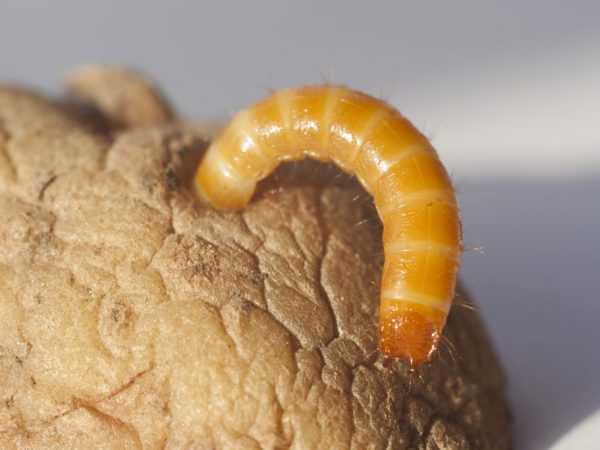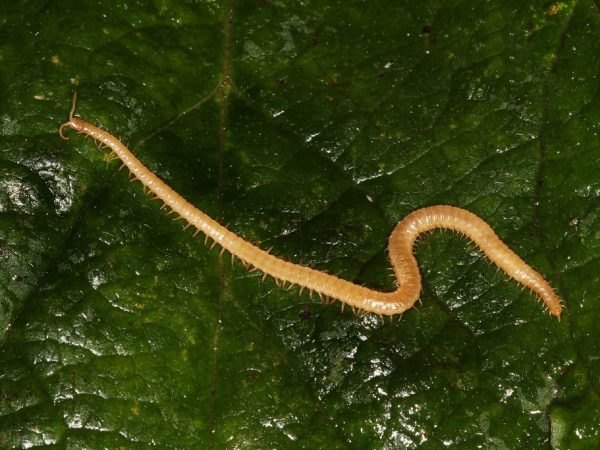How to deal with wireworm on potatoes
In the process of growing potatoes, many, when harvesting, are faced with the fact that among the root crops there are many of those that are cut through by back doors. Experienced gardeners are familiar with this problem and know very well that this is the result of the presence of a wireworm in the soil that loves vegetables. Those gardeners who have been planting a vegetable crop in their personal plot for several years are already familiar with how to deal with wireworm on potatoes, and have long used active measures to combat it in spring and autumn in order to destroy the pest in a short time and save their harvest.

Fighting wireworm on potatoes
Chemistry versus wireworm
The most effective way to combat the pest is drugs - insecticides, which are designed to process tubers from the wireworm in potatoes in spring with them before planting. When using poison for planting material, protection of potato root crops from the clicker, Colorado potato beetle, bear, beetle and plant disease can be provided for a long time - up to two months.
Gardeners do not recommend treating early potato varieties with insecticidal preparations in the spring. This method of dealing with wireworm on early maturing potatoes is not very helpful. The shorter ripening period of their roots prevents the concentration of the chemical from decreasing, and as a result, the chemical gets into the ripened vegetables.
Varieties with medium and late ripening periods are treated, as a rule, with the help of such chemical insecticidal agents for wireworm on potatoes as Prestige, Commander, Tabu, which also create protection and allow you to get rid of the Colorado potato beetle.
Homemade chemical solutions
On the advice of experienced gardeners, many have adapted to prepare combinations using chemical components that the wireworm does not like, making their own preparations with them. Among the most commonly used treatments to get rid of the wireworm on potatoes as efficiently as possible before planting is a superphosphate-based working solution:
- 5 kg of granular superphosphate is scattered on a film coating in a thin layer,
- a choice of one of the proposed active ingredients in the prescribed dosage: 0.4 ml of the drug Decis, or 1 ml of Karate, or 15 ml of Actellik or 2 ml of Fastak,
- the selected chemical is diluted with an aqueous acetone liquid, which is prepared in a ratio of 800 ml to 200 ml, respectively,
- the resulting composition with the active component is sprayed onto the superphosphate and left on the film until it dries completely.
The treated chemical composition of superphosphate is sprinkled on the soil in the garden before planting potato tubers.The amount prepared is enough for about 100 square meters of cultivated area, so that the wireworm does not appear in the potatoes.
Folk remedies for wireworm
Among the methods of how to deal with a wireworm on potatoes, there are folk remedies. It is them that gardeners love and often try to use them so as not to harm the future harvest and not spoil the soil with chemicals.
Herbs
Many herbal infusions are effective against wireworms:
- infusion of celandine is prepared in the proportion of 100 grams of grass per ten-liter bucket of water, keeping it for three days,
- for an infusion of nettle, you need 0.5 kg of grass for the same volume of water, infused for 12 hours,
- dandelion infusion requires 200 grams of grass per 10 liters of water, it is also kept for half a day.
Sowing root crops are treated with these solutions before planting in a weekly interval. Gardeners recommend processing the seed every two days before planting. After planting such herbal infusions with celandine, mustard, nettle and coltsfoot, potato bushes are watered as they grow and develop.
Shell

Eggshells Can Help
Eggshells are effectively used by experienced gardeners as an effective measure against the nutcracker. On the advice of experienced gardeners, potato tubers are treated with finely chopped egg shells before planting. In addition, eggshells can be placed in the hole just before planting the tuber in the soil.
On the advice of some gardeners, egg shells can be replaced with onion or garlic husks, which is no less effective measure of how to get rid of the wireworm on potatoes. Many sprinkle the holes with mustard.
In addition, there are some summer residents who, in addition to the measures taken to get rid of the wireworm in the potatoes, like to spread the crushed eggshells and sprinkle with mustard around the entire perimeter of the land plot on which the potato crop is grown.
Ammonia
Ammonium sulfate, or there is another similar effective remedy that can be used to fight wireworm on potatoes, ammonium nitrate, is often used as folk methods that can destroy the pest. They contain an active component of ammonia. It acts as a reliable deterrent for the larvae of the click beetle, forcing it to bury itself to a great depth in the soil, leaving it without food, which leads to the death of the insect. The calculation of the use of drugs is about 20-30 grams per square of sown area.
Potassium
One of the effective folk methods in the fight against wireworm on potatoes is potassium permanganate, or potassium permanganate, which is poured into a hole in the soil just before planting. A solution with potassium is also used in the process of growing a potato crop when processing adult bushes. The proportions for the working fluid for treating tubers before planting and during the development of a vegetable crop are 2-4 grams of potassium permanganate powder per ten-liter bucket of water.
Mechanical methods
When growing a vegetable crop on a small area, and not in the conditions of industrial agricultural production in the field, there are labor-intensive, but no less effective ways of fighting that gardeners resort to, using mechanical means of collecting its larvae.
Traps
Among the mechanical folk measures against the beetle - the clicker - traps specially prepared for the worm, made from potato tuber, which allow you to fight the pest of the crop. For this purpose, root crops - traps without eyes are soaked in an insecticidal agent for one day. 3-4 days before planting potatoes, traps from the processed vegetable for the wireworm are buried in the supposed place of a large accumulation of worms.After a lapse of time (usually two or three days are enough for this), such an insecticidal tuber of the potato affected by the wireworm is dug up, the trap is cleared of larvae or is simply burned. The procedure for the mechanical method of dealing with traps is repeated as often as possible throughout the gardening season.
Poisoned Seeds
Planting poisoned corn, wheat or oat seeds before planting a vegetable crop is suitable as a mechanical measure for controlling wireworms on potatoes. A natural poison is planted about a couple of weeks before planting the seed tubers. After two weeks, the seedlings in the sowing field are dug up together with the larvae of the click beetle on their roots and burned. Only after such cleaning, sowing potatoes are already planted in the soil.
Agrotechnical measures

You can get rid of the pest
Agrotechnical measures taken in time before planting potatoes allow you to preserve the future harvest.
Liming
The larvae of the click beetle prefer highly acidic soil soils, therefore, one of the ways to get rid of the wireworm is to maintain the acidity of the earth at the proper level. The real natural enemy of the pest is the regular liming of the soil with the addition of ash, lime and chalk.
Determine that the soil has increased acidity indicators, allow plants that act as indicators. If horsetail and sorrel with plantain feel favorable in your garden, this is an excuse to take measures against high acidity and lime the soil.
As a means in the fight against wireworm, dolomite flour helps well, which is applied once with an interval of 3-4 years. Regular cultivation of the land allows you to remove the pest from the suburban area.
Crop rotation
The wireworm usually does not infect crops planted on a personal plot for only the first year, therefore the most important measure in the fight against a pest, which allows you to protect the future harvest, is the annual change of crops in the beds. Correct crop rotation will allow you to fight not only the clicker, but also the Colorado potato beetle.
Weeding
Burdocks and wheatgrass become a factor contributing to the spread of the pest, attracting the wireworm to the potato bushes. Regular weeding of the beds and their timely cleaning of weeds will slow down the process of rapid reproduction of larvae.
Digging the earth
At the end of the gardening period in the fall, experienced gardeners strive not only to remove all the tubers in the garden, but also to dig up the ground as thoroughly as possible, doing it as deeply as possible, lifting up individual soil layers lying at a sufficiently large distance from the surface. This is done so that the larvae of the worm hit the surface of the soil and die in late autumn when frost occurs.
When the pre-planting earth digging begins in the spring, it is recommended to dig at a shallow depth, and timely remove the larvae of the wireworm, and not bury it in the depths of the soil.
Biological measures
As biological measures in the fight against the wireworm, in order to destroy the pest, summer residents often seek to plant garden plants in the garden that he does not tolerate, and also use the services of the natural enemies of the beetle - the clicker.
Crops
Some experienced gardeners noticed that the wireworm loves salad roots, therefore, to preserve the potato harvest, varieties of salads are often planted between the ridges, so that later, with the roots and the wireworm larvae on them, pull the pest out of the soil.
Instead of attracting a pest of plants, you can protect the potato crop by using crops of those crops that have a deterrent effect for it:
- siderates, which emit a persistent smell of essential oils during their rotting, scare away the pest from potato root crops, among the most unpleasant for the larvae of the beetle - the siderat nutcracker - mustard, buckwheat, sweet clover flowers, rape and rapeseed, siderat crops are planted on the ridges in the fall, when the potato crop is harvested, or before planting potatoes in the spring, plants that have grown up to 10 cm tall - siderates are mowed and mixed with the soil.
- garden crops - marigolds and dahlias, which scare off larvae with their smell,
- legumes (beans, peas and beans) - planted during spring, these garden crops will provide protection for future potato harvests and at the same time enrich the soil with a nitrogen component necessary during the growth stage and during the development of potato bushes.
Attracting birds
The creation of favorable conditions for birds on the backyard during spring allows you to attract birds, which are natural enemies of the wireworm. They eat the nutcracker and its larvae. Among the birds that feed on wireworms are starlings and rooks, wagtails and blackbirds.


